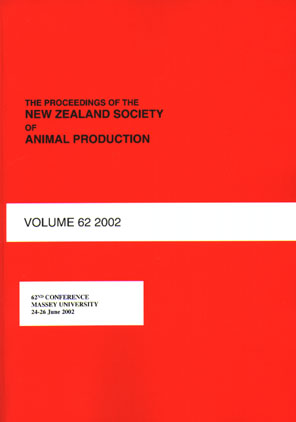Abstract
Sixty-eight weaner deer were allocated to grazing perennial ryegrass-based pasture or chicory from 18 March to 20 May 2002, and within these groups were either regularly treated four-weekly with anthelmintic or treatment was withheld until weight loss or clinical signs of parasitism such as coughing was observed (trigger treatment). Liveweight gain was monitored fortnightly. Five sentinel deer from each of the four groups were slaughtered for nematode counts on 20 May. Deer grazing chicory grew faster than deer gazing pasture (P<0.001). Thirty five percent of trigger-treated deer grazing pasture required treatment for clinical parasitism, but no anthelmintic was required for trigger-treated deer grazing chicory. There was no effect of anthelmintic treatment on average autumn growth of deer grazing chicory, but trigger-treated deer grazing pasture grew at half the rate of regularly treated deer (P<0.01). Deer grazing chicory and treated four-weekly with anthelmintic grew 1.5x faster than deer grazing pasture and treated four-weekly with anthelmintic (P<0.05). This difference in growth of deer grazing chicory and pasture increased to 2.9x when comparing triggertreated deer grazing the two forages (P<0.01). Sentinel trigger-treated deer grazing chicory had half the lungworm population of deer grazing pasture (P=0.13) and 18% fewer gastrointestinal nematodes (P=0.06). This study shows that grazing young farmed deer on chicory during autumn can increase their resilience to internal parasitism, reducing anthelmintic use whilst increasing deer growth.
Proceedings of the New Zealand Society of Animal Production, Volume 63, Queenstown, 269-273, 2003
| Download Full PDF | BibTEX Citation | Endnote Citation | Search the Proceedings |

This work is licensed under a Creative Commons Attribution-NonCommercial-NoDerivatives 4.0 International License.

